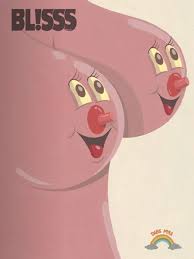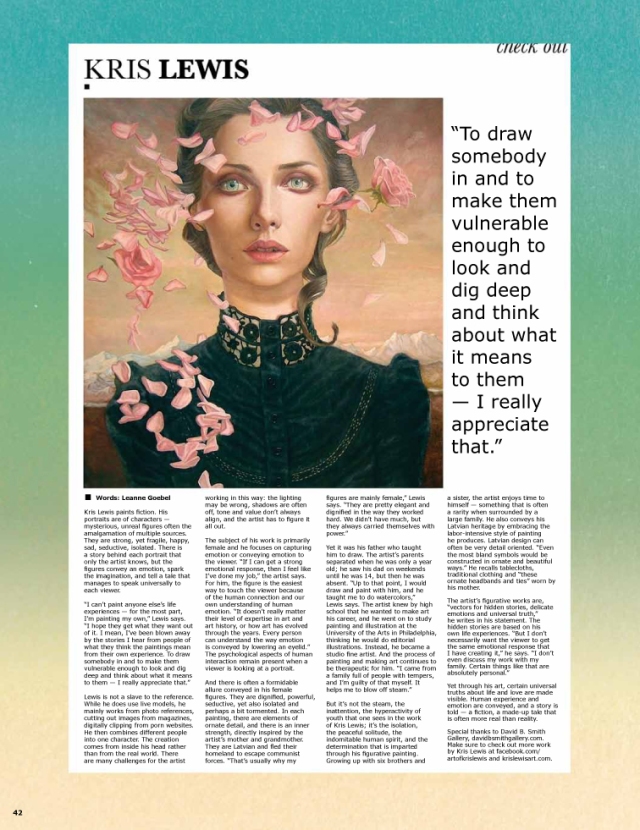Kris Lewis by Leanne Goebel
 Kris Lewis paints fiction. His portraits are of characters — mysterious, unreal figures often the amalgamation of multiple sources. They are strong, yet fragile; happy, sad, seductive, isolated. There is a story behind each portrait that only the artist knows, but the figures convey an emotion, spark the imagination, and tell a tale that manages to speak universally to each viewer.
Kris Lewis paints fiction. His portraits are of characters — mysterious, unreal figures often the amalgamation of multiple sources. They are strong, yet fragile; happy, sad, seductive, isolated. There is a story behind each portrait that only the artist knows, but the figures convey an emotion, spark the imagination, and tell a tale that manages to speak universally to each viewer.
“I canʼt paint anyone elseʼs life experiences — for the most part, Iʼm painting my own,” Lewis says. “I hope they get what they want out of it. I mean, Iʼve been blown away by the stories I hear from people of what they think the paintings mean from their own experience. To draw somebody in and to make them vulnerable enough to look and dig deep and think about what it means to them — I really appreciate that.”
Lewis is not a slave to the reference. While he does use live models, he mainly works from photo references, cutting out images from magazines, digitally clipping from porn websites. He then combines different people into one character. The creation comes from inside his head rather than from the real world. There are many challenges for the artist working in this way: the lighting may be wrong, shadows are often off, tone and value donʼt always align, and the artist has to figure it all out. He begins by sketching, merging the references through drawing, making subtle distortions in the same way that Jean-August Ingres lengthened the spine of the figure in “La Grande Odalisque” and John Currin exaggerates and distorts the erotic female form. Lewis strives to make the characters caricature-like and not cartoonish. Sometimes he recreates the drawing in Photoshop to help with the lighting, shadows and color, which takes less time than doing color study after color study. The process helps him nail down the tone and value. This is the image he will use as a guide for the painting.
“But I usually end up changing things,” Lewis admits. “I had attention deficit disorder as a child, and it takes these really intense works that I get lost in to keep my focus. When I just really focus in on the detail, thatʼs when I zone out. But I canʼt stop myself from changing things. I spend all this time to get this composition drawing done, and then I change everything.”
He uses the warm under-painting technique of William Bouguereau and tones the painting down with cool value. (Bouguereau and other 19th Century painters often began by washing their canvases with Permanent Red.) Just as the classicists, Lewis finds it easier to cool down the figure than to warm it up. Lewis works with oil paints, in the traditions of the old masters he admires: Hans Holbein, Albrecht Dürer, Andrew Wyeth, Antonio Mancini and Jules Bastien-Lepage. He paints on canvas or wood with a high level of detail and uses items that are personally symbolic to him, adding his own modern mythology to the work to create the narrative.
The subject of his work is primarily female and he focuses on capturing emotion or conveying emotion to the viewer. “If I can get a strong emotional response, then I feel like Iʼve done my job,” the artist says. For him, the figure is the easiest way to touch the viewer because of the human connection, and our own understanding of human emotion. “It doesnʼt really matter their level of expertise in art and art history, or how art has evolved through the years. Every person can understand the way emotion is conveyed by lowering an eyelid.” The psychological aspects of human interaction remain
present when a viewer is looking at a portrait.
And there is often a formidable allure conveyed in his female figures. They are dignified, powerful, seductive; yet isolated, perhaps a bit tormented. In each painting, there are elements of ornate detail, and there is an inner strength, directly inspired by the artistʼs mother and grandmother. They are Latvian and fled their homeland to escape communist forces. “Thatʼs usually why my figures are mainly female,” Lewis says. “They are pretty elegant and dignified in the way they worked hard. We didnʼt have much, but they always carried themselves with power.”
Yet it was his father who taught him to draw. The artistʼs parents separated when he was only a year old; he saw his dad on weekends until he was fourteen, but then he was absent. “Up to that point, I would draw and paint with him, and he taught me to do watercolors,” Lewis says. The artist knew by high school that he wanted to make art his career, and he went on to study painting and illustration at the University of the Arts in Philadelphia, thinking he would do editorial illustrations. Instead, he became a studio fine artist. And the process of painting and making art continues to be therapeutic for him. “I came from a family full of people with tempers, and Iʼm guilty of that myself. It helps me to blow off steam.”
But itʼs not the steam, the inattention, the hyperactivity of youth that one sees in the work of Kris Lewis; itʼs the isolation, the peaceful solitude, the indomitable human spirit, and the determination that is imparted through his figurative painting. Growing up with six brothers and a sister, the artist enjoys time to himself — something that is often a rarity when surrounded by a large family. He also conveys his Latvian heritage by embracing the labor-intensive style of painting he produces. Latvian design can often be very detail oriented. “Even the most bland symbols would be constructed in ornate and beautiful ways.” He recalls tablecloths, traditional clothing and “these ornate headbands and ties” worn by his mother.
The artistʼs figurative works are “vectors for hidden stories, delicate emotions and universal truth,” he writes in his statement. The hidden stories are based on his own life experiences. “But I donʼt necessarily want the viewer to get the same emotional response that I have creating it,” he says. “I donʼt even discuss my work with my family. Certain things like that are absolutely personal.”
Yet through his art, certain universal truths about life and love are made visible. Human experience and emotion are conveyed, and a story is told — a fiction, a made-up tale that is often more real than reality.
Special thanks to Special thanks to David B. Smith Gallery davidbsmithgallery.com


Leave a comment